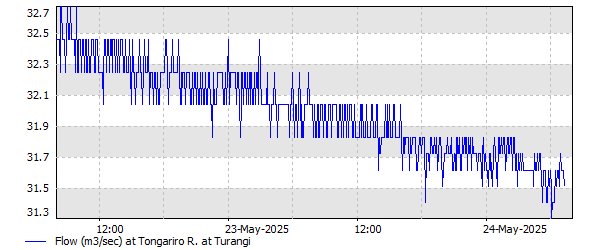Lake Level and River Flow

Before 1941
Up until 1941, Lake Taupo was a natural lake, this changed when control gates were installed at the head of the Waikato River which is the only exit from Lake Taupo. The Waikato River was to become a river for hydro power generation. This was done by the government through the New Zealand Electricity Department. Over the next 23 years a total of 8 hydro dams were built producing 994MW of electricity.
Deregulation
On 1st April 1987, the government took the first step towards deregulating the electricity sector and formed the Electricity Corporation of New Zealand (ECNZ). In 1996 ECNZ was split into two State Owned Organisations - ECNZ and Contact Energy. Later, on 1st April 1999 ECNZ was split into three competing companies – Meridian Energy, Genesis Energy and Mighty River Power which is now Mercury Energy. Control of the hydro stations on the Waikato River and the level of Lake Taupo were given to Mercury Energy.
The Tongariro River along with the diversion flow through the Tokaanu Power Station is the major flow of water into Lake Taupo. The Tongariro Power Scheme and subsequent river flow is controlled by Genesis Energy.
Mercury Energy have the responsibility of controlling the lake level between a minimum level of 355.85masl (metres above sea level) and a maximum level of 357.25masl. Current lake levels and flow rates into the Waikato River can be found on the Mercury Energy website - https://www.mercury.co.nz/lakelevels.

River Flow
The Tongariro River originates in the Central Plateau of the central North Island, and originally the Waikato River. In 1945 the section from the Waihohonu Stream down to Lake Taupo was named the Tongariro River. It has a large catchment area extending from the eastern slopes of Mounts Tongariro, Ngauruhoe, and Ruapehu and into the Kaimanawa Ranges. The catchment area contains a number of major tributaries including the Waihohonu Stream, the Waipakihi River, and Poutu Stream.
The flow of water down the Tongariro River was altered with the construction of the Tongariro Power Scheme and the Advocates for the Tongariro River are concerned that higher lake levels mean that the river is not able to carry its bedload into the lake resulting in a build-up of sediment in the lower river which reduces its capacity to contain flood flows. On average 10,700 tons of gravel and larger size sediment is carried past Turangi each year with three times this amount of finer sized material including sand.
The flow of water down the Tongariro River have been continuously recorded since 1957 by a gauge located at Turangi. An average flow is between 20 and 25 cu m/sec, with two extreme floods recorded in 1958 and 2004, both exceeding 1400cu m/sec. The Resource Management Act requires that as part mitigation for the loss of recreational amenities on the Tongariro River, Genesis Energy must divert water into the river for three weekends per year. This is separate from any maintenance or flushing flows that may be necessary. The dates for these recreational releases are set in conjunction with Whitewater NZ.
The Tongariro River is New Zealand’s most fished river and is considered to be one of the best wild trout rivers in the world and consequently a drawcard for anglers worldwide.
The Advocates' Position
The Advocates' position on the Tongariro River is:
- That we accept that the lake be used for electricity storage
- That the lake level will fluctuate due to natural events
- That the lake level is held too high beyond what would be a natural term
- That the higher lake level causes problems in the lower Tongariro River

River flow information for the Tongariro
Measured at the Major Jones pool, from Genesis Energy.
Reviewed March 2023
